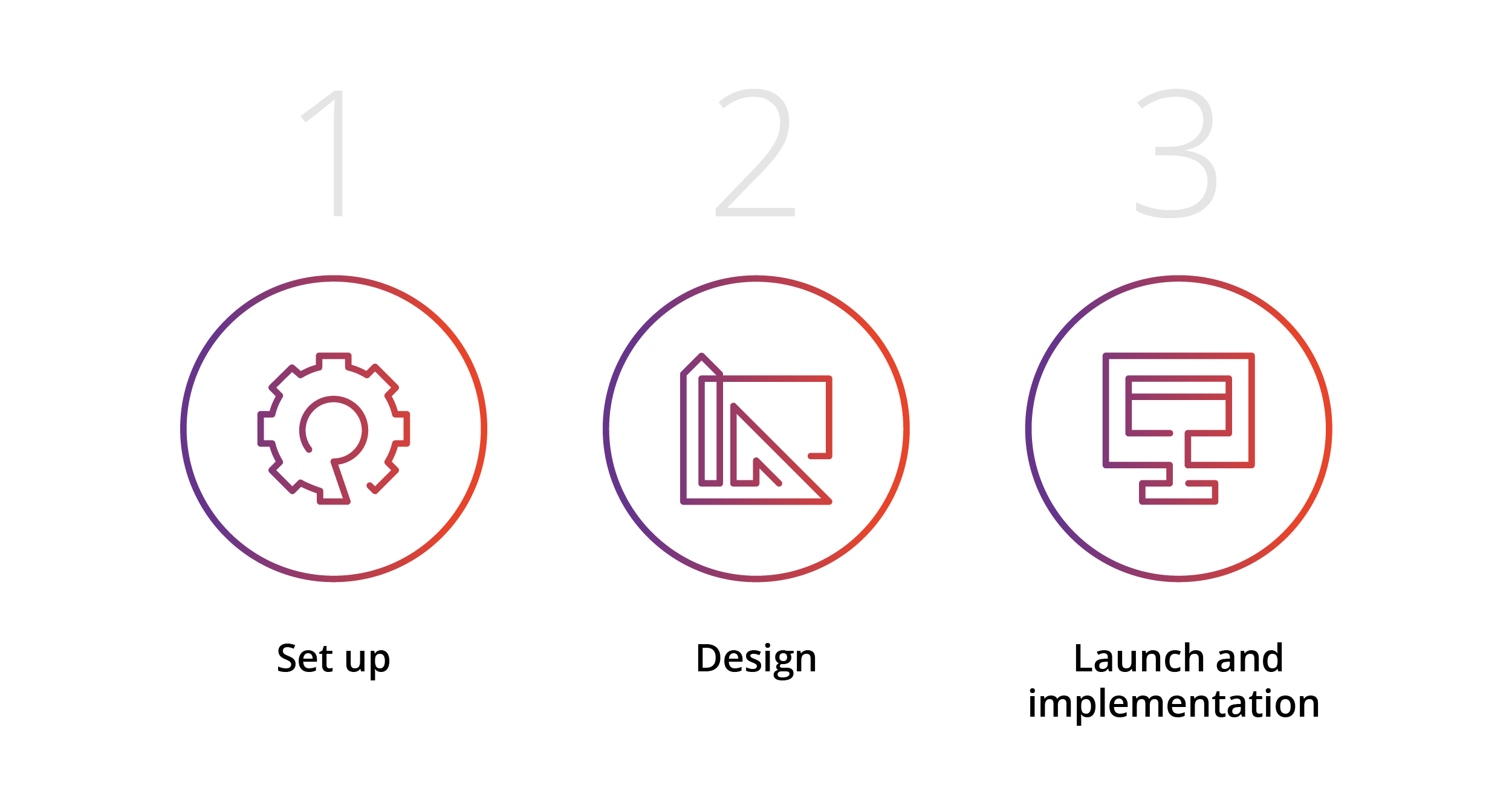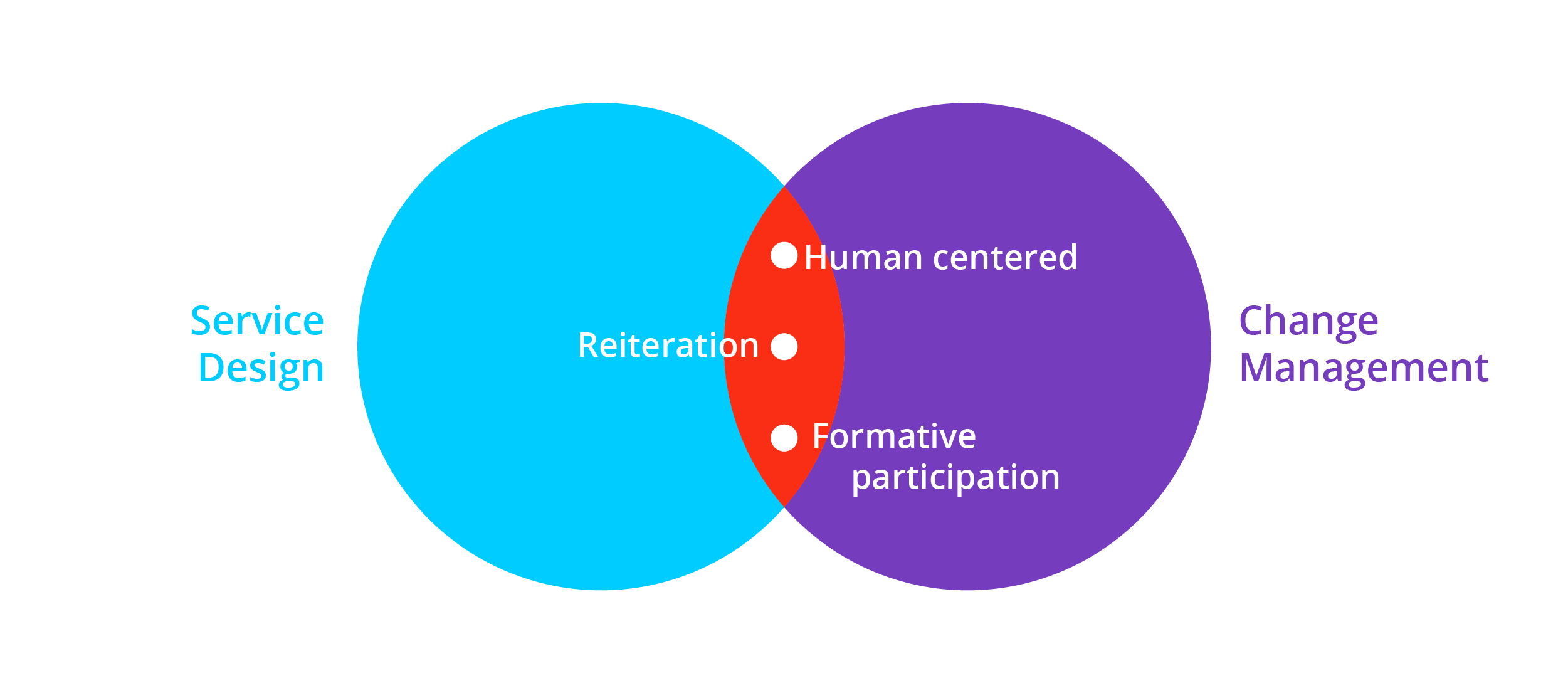Service design & Change management: a successful contamination for a systemic approach
As professionals, every day we interface with figures from different academic and disciplinary fields: we get combined in the field and then we concretely test ourselves on projects.
Each role is selected to compensate the skills of the other, raise the quality of the teamwork and provide the customer with a team that can respond best to project needs.
With time and with the experience gained, we realized how here in Openknowledge this multidisciplinarity has become one of the strengths of our way of consulting.
This is the case of Change management experts and Service designers who often collaborate to find common patterns and identify the right way to create the design solution. Two figures with different backgrounds and points of view, but with similar approaches: both put people at the center and design transformation paths built around the context, needs and aspirations of users.
In the last few months, the differences between these two professional profiles gave birth to surprises, confirmations and new opportunities, creating greater value for the customer throughout the whole support and change process.
We want to start from here to highlight the beliefs about these disciplines, break them down and narrate the initiatives that have made the difference.
Re-discover the tools of one’s resources
Try to think about a common issue: headache. When you want to find the solution (other than taking medications and checking on Google) which of these professional do you turn to: doctor, ophthalmologist or dentist? None of the three hypotheses would be wrong, as their treatments, although different, can all be effective – hopefully!
But what would happen if all the figures, with due regard for their disciplines, confronted each other before taking action?
They would certainly tackle the problem in a more holistic way, and they would always be enriched by it if they are well prepared for listening and self-criticism. They could also probably find out that some of their own beliefs did not have a global view on the same issue.
When we look at a problem from a single point of view, that of experts in a single discipline, we are not aware of these beliefs until an external factor points them out to us. A myopia that leads us into making mistakes that sometimes cause more damage than the work itself. This phenomenon is called “iatrogenic”, or the tendency of the healer to cause damage with his intervention.
It happens in projects where we are not open to listening to other professional figures coming from a different area of expertise, when the chance to build heterogeneous teams is not even considered, or when specific and vertical expertise do not have the possibility to interface with experts on other themes.
The literature is filled with lists of risk factors if a project fails and statistics on the poor effectiveness of most business initiatives, whether they are carried out within organizations or in collaboration with business partners. More than scarce effectiveness, we can say that they have a separate effectiveness: they obtain successful results in the single direction, but not in the overall system.
What does it mean? It means that they suffer from myopia, that the solution studied was carried out by a single area of expertise and that the impacts on all the variables and actors of the corporate ecosystem have not been taken into account. As a result, the new project does not link well to existing ones, employees are unlikely to open up to the adoption of new practices and the costs (real or perceived) outweigh the benefits and discourage the inclusion of a new initiative.
In a nutshell, we approach the problem from a single point of view and remain trapped in a new solution, but already full of obstacles and frictions, a solution that is destined not to take off, or in the case of a headache not treating it for what it’s actually caused by.
Having had the opportunity to experience the contamination between Change management experts and Service designers, especially in Employee Experience projects, we realized that the path is full of pitfalls. The moments of analysis, collaboration, training and implementation sometimes don’t take into account the presence of some factors, coming from the myopia of the single professional figure, but if brought to light, phase by phase, they can be avoided in order not to cause iatrogenicity. Let’s see together which ones:
- Set-up phase:
- Identification of the objectives and problems to be solved (even in the long term), focusing on activities with a high strategic value (important ones) over the urgencies of Business as Usual;
- Buy-in solicitation, i.e. the involvement of all stakeholders from the early stages.
- Design phase:
- Taking into account the obstacles (even if uncomfortable to admit);
- Testing of solutions before go-live;
- Development of solutions in a participatory and iterative way.
- Launch and implementation phase:
- Prioritization of outputs and elimination of those misaligned with the expectations of all stakeholders;
- Active involvement of the various stakeholders in the implementation of activities and initiatives as real agents of change, to increase ownership and accountability towards new solutions;
- Incentive to stakeholder commitment for disclosure and monitoring.

Overcoming traditional pain points
Before working together in the world of consultancy, Change Management and Service Design have worked for years following their own methods, approaches and tools in solitude, without having the possibility of comparison but above all limiting their opportunities for discovery.
On the one hand, Service Design focused on designing new solutions for improving experiences, on the other, Change Management aimed at supporting the strengthening and growth of people and their skills.
Recognizing ourselves in expressions like “we do it too but in a different way” or “we apply this tool in another phase” were the key factors that allowed us to bring out points of contact and overlap, but also shortcomings.
If on the one hand the Service designers were (and still are) involved mainly in the initial research and conceptualization phases, not being completely able to reach the full realization of the concepts developed, on the other hand the Change management experts came (and still are) called when it’s all done, for example to guide the implementation of a change plan, with a consequent entropy and difficulty in sense making.
Sometimes these choices affect the core decisions between the design phases, not allowing the two figures to meet, interact or simply pass the baton, in order to guarantee continuous accompaniment and satisfy the customer’s expectations.
Designing Sustainable Change
Our nature in OpenKnowledge is based on hybridization and contamination between expertise, we involve both figures by aggregating the best skills of both profiles to achieve systemic, effective and sustainable changes over time. Thus transforming the weaknesses into strengths.
From what we have learned, 3 shared pillars were born that characterize our approach to new ways of working, adoption and digital transformation projects.
1. Human centered
While Service Design brings a method into research on human behavior, Change Management helps to interpret them and scale complexity. By putting them together we are able to tackle the introduction of new behaviors, processes, tools and products while keeping the person at the center of transformation, as a user and agent of change itself.
2. Reiteration
The most used tool to avoid ignoring complexity is solutions testing by using prototypes or pilot projects. This helps to check for possible failures in order to avoid them before the solution or the change plan are implemented.
3. Formative participation
Every moment and every project phase is approached in a participatory way with the stakeholders and with the end users of the product, service or change plan. In these moments, the focus is not only on retrieving information by stakeholders, but also on the growth of people in order to obtain positive results of ownership and accountability.
The conceptual artifacts are co-conceived with the actors through new ways of participation and involvement that allow them to experience real moments of change and training on their working methods, beliefs and ideas.

Our experimentation
Here’s how our multidisciplinary experience allows us to enrich projects and activities:
- We create moments of management involvement through listening and co-creation activities to define the pillars of the new business strategies and the steps necessary to achieve them. Always taking into account the necessities, needs and aspirations of the actors involved, the organization and the context in which it is located;
- We design events in which participants have the opportunity to build, even physically, prototypes that allow them to experience and understand a new product, an operating model or a process, before it is implemented, in order to underline its benefits and obstacles;
- We communicate through creativity and storytelling to increase the effectiveness and perceived value of the adoption or up-skilling and re-skilling activities, in order to be welcomed in a favorable manner by all interested parties. An example of success stories are our “tales from other worlds” which we have used for clients such as UBI Banca and Generali;
- We create post-intervention training artifacts, which not only leave a memory of the planning process made with the stakeholders, but also a guide for the behaviors to be adopted in the future. For example, the guide-books that we release after the adoption of platforms and processes, or the templates that enable subsequent co-design activities to be carried out independently.
These activities, carried out in a collaborative and synergistic way between Service designers and Change management experts, have allowed us to experiment with new methods, reflect on our mixture of skills and govern those risk factors that often become hidden pitfalls in design paths.
These are solutions that transform OpenKnowledge into an open “laboratory”, where market demands are accepted and the challenges of organizations are embraced, to become a leading partner towards the change and design of innovative solutions.
These solutions, or resolutive activities, are often very simple; things that would never have entered our work as single experts in the field. Certainly not with the speed and effectiveness with which we experienced them. The value of the hybridization of disciplines lies in these fundamental details capable of compensating for myopia that too often make us look at the finger instead of the moon, perhaps with a good pair of glasses.

 9 December 2020
9 December 2020
